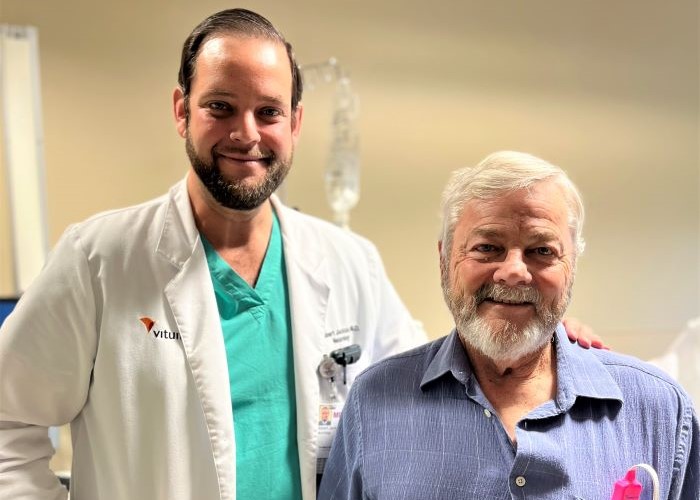Fast-Acting Care Team Helps Man Survive Multiple Strokes
January 23, 2024
 73-year-old Gary Carlson is a retired oil refinery worker and lifelong resident of Southern California. He and his wife Carole recently celebrated their 50-year anniversary. One Sunday this past December while getting Christmas decorations out of the attic in their home in Wildomar, Gary suffered a stroke.
73-year-old Gary Carlson is a retired oil refinery worker and lifelong resident of Southern California. He and his wife Carole recently celebrated their 50-year anniversary. One Sunday this past December while getting Christmas decorations out of the attic in their home in Wildomar, Gary suffered a stroke.
Carole was the first to notice something was wrong. “He had seemed off for a couple of weeks before it happened. There were no symptoms, but he just wasn’t his usual self; he was tired,” she recalls. While calling down to her from the attic, Gary struggled to read the labels on boxes and pronounce words. Carole, being a retired registered nurse, knew the signs of a stroke and had him come downstairs.
Although his mobility was fine, it was clear to her that he was mentally incoherent. “I had him sit down and asked him to identify objects in the room, which he could," she says. “When I asked him if he could say his ABCs, he was able to say the first few but then it was like his tongue was stuck to the roof of his mouth.” Having seen enough, she immediately took him to Temecula Valley Hospital.
Quick response from emergency department
From the time Carole first noticed the symptoms, it took them 45 minutes to reach the hospital. According to her, Gary received amazing care as soon as they walked through the door. “A triage nurse looked at him right away and said they were taking him to the ER and calling a code stroke. He made sure we knew what was going on so we weren’t alarmed,” she says. “He was very helpful and gave excellent care from the moment we got there until Gary was discharged.”
The first thing the emergency department did was take Gary’s blood pressure, which was extremely high. He spent a few days in the hospital while they ran tests to determine the cause of his condition. It was during this time that he suffered another stroke.
Suffering a second stroke at the hospital
Gary was on the neurology floor one day when his speaking difficulty returned. “It would come and go for maybe a few seconds,” Carole recalls. “He was slurring his words again.” Robert J. Jackson, MD, Stroke Medical Director of Temecula Valley Hospital, was there in a matter of minutes. He determined that Gary was suffering a transient ischemic attack, a type of stroke that lasts for only a few minutes.
Assuming the attack was caused by plaque buildup in the carotid artery, Dr. Jackson immediately confirmed his suspicion by running an MRI and ultrasound. “He was very knowledgeable and reassuring,” Carole says. “Before getting the results, he knew which side of the brain was being affected based on the fact Gary’s language was affected.”
Dr. Jackson then conducted a procedure known as TCD emboli detection and realized the plaque in the carotid artery was flaking off, which posed a serious risk of causing another stroke. He ran a few more tests to make sure there were no other factors exacerbating Gary’s condition before scheduling him for surgery.
Surgery to remove plaque from the artery
The procedure took place two days later. Vascular surgeon Brian Tiu, MD, RPVI, made an incision in Gary’s neck and cut the carotid artery lengthwise to remove the plaque. He then replaced the removed section of artery with a bovine patch, which is made from a cow’s heart. The surgery was successful with no complications.
Dr. Jackson assured the Carlsons that there was no risk of rejection to address any concerns they may have had about the bovine patch. He also explained that the plaque had broken into two chunks, which caused the flaking. “He drew pictures to explain it all to us,” Carole says. “He was very thorough and described it to us in understandable terms. He is very down to earth.”
Grateful for a smooth recovery
Gary was discharged from the hospital a few days later and has been regaining his strength at home ever since. While he has shown no residual effects or signs of stroke symptoms since being home, he is refraining from manual labor and heavy lifting for the recommended six to eight weeks until he is fully recovered. “It’s been hard keeping him out of the garden and backyard,” Carole says jokingly.
“We’re people of faith,” Carole says, reflecting on the experience. “I believe we were put in the right hands and that it was a miracle everything fell into place the way it did. We are very thankful and feel blessed for the care he received at Temecula Valley Hospital.”
